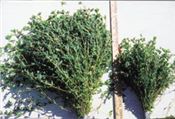Legend Lespedeza – A Great Fit On Both Sides Of The Ledger
KEITH CARMICHAEL
LOWRY CITY, MO.
Summer is just weeks away Predictions swirling around for 2017 include very little improvement for beef prices and the possibility of some extended drought conditions in some regions. That means that every serious manager facing this possible scenario had better be looking for ways to manage on both sides of the ledger. Increase returns, and reduce inputs. Annual lespedeza for grazing or hay can do both – adding to the bottom line. But this takes planning now - in February. It doesn’t ‘just happen.’ Ask yourself: “What fits best?”
More pounds of beef.
Ask any old timer who has used lespedeza in the past and they’ll tell you – “lespedeza is better than feeding grain when it comes to putting pounds on calves.” They are also usually quick to add: “We all still sell cattle by the pound.” Adding Legend lespedeza into cool-season grass pastures provides that badly needed protein source for late summer, and an added bonus is its ability to help dilute ‘hot’ KY-31 pastures when other legumes are long gone. The fescue fungus affects all of animal performance – including reproduction. Quality grazing means more pounds and higher conception rates. Letting cattle ‘stall-out’ and go backwards in the late summer affects the bottom line, but it doesn’t have to happen. Legend lespedeza is high in protein and has proven to be drought resistant. It’s all about ‘timing’! Legend lespedeza provides a ‘home-grown protein’ boost, and provides it WHEN YOU NEED IT MOST.
Legumes pay their own way
In addition to being an essential protein source in the pasture mix; legumes like clovers and annual lespedeza add diversity and produce their own nitrogen, which eventually becomes available to grasses as well. At today’s nitrogen prices, the cost of seed and establishment is easily offset by an increase in animal performance or the added nitrogen produced – one or the other is FREE – take your pick. Over-seeding pastures and hay fields with legumes is basic, common sense management, but which is best for your operation? The answer is probably… ‘All of the above’. No single legume can do it all. Soil fertility, pH, texture, and drainage all help determine which legume is best for a particular soil-type.
A Great Companion for Novels
What fits best? Many producers are looking at using the newer, safer types of fescue. Not every legume is ideal as a companion that first season. Annual lespedeza is the one legume that can be recommended as a companion legume the first season because it does not compete aggressively with the new grass early in the spring. Remember: There is likely to be that ‘summer gap’ unless you guard against it with plant diversity.
Great for Stockpiled Pastures
What fits best? Fall stockpiling of fescue pasture is very important in many operations and it should be stressed that the management required to stockpile this forage fits very well in allowing annual lespedeza to re-seed itself.
Renewed Interest in Lespedeza
Interest in annual lespedeza continues to get stronger each year because no other legume is both tolerant to drought conditions and low pH soils. It is also one of the few legumes that do not cause bloat. The renewed interest in annual lespedeza also has a lot to do with the continued success of Legend lespedeza, an annual-striate lespedeza that is nearing its 20th year of commercial production.
Annual lespedezas should not be confused with its perennial cousin, Sericea, which is a serious weed problem in many areas.
For More information visit www.Legendlespedeza.com . ∆
KEITH CARMICHAEL: Editor/Midwest Cattleman, Agricultural Educator & Cattleman, Owner/Cutting-Edge USA, LLC

Legend lespedeza, right, next to the once poplar Marion variety,
is nearing its 20th year of commercial production.